Kunst ist wenn man trotzdem lacht
Today I visited the Thaddaeus Ropac gallery in Mayfair. Their latest exhibition is a retro perspective of German artist Joseph Beuys.
The Beuys myth says that when he was a pilot during World War II he crashed his Stuka over the Crimea. Later he was found by a tribe of nomadic Tartars. They wrapped him in fat and felt to keep him warm to save his life.
His whole legacy, also art revolves around this myth, which mainly includes medicine, fat, felt and electricity.
"Art as a spiritual first aid for a damaged national psyche, sculpture as a healing object, performance as shamanic ritual – and it’s some of the most important art of the twentieth century." - Eddy Frankel
He became famous through political activism and some really controversial statements on art. As a lecturer, he questioned and educated a whole generation of artists.
 |
| "Kunst ist wenn man trotzdem lacht" |
Even though he is so famous within the art scene and his name is recognisable most people in Germany don't relate any work with him. He is a concept artist, someone who only talks and never walks.
That was the misbelief I grew up in, which was so wrong. When I first went to Tate Modern I saw one of the biggest installations in my life, made by Beuys. It seemed like the whole story was dedicated to him. After realising that there was so much more to him and also more than information displayed at Tate I was happy to find out about the exhibition at Thaddaeus Ropac.
Beuys was older than my grandparents, though they were roughly in the same generation. To me, it is fascinating to see how the war formed different people and also how war formed people in general. Art was an escape and also a way of expression, rebellion and also understanding (each other). Art wasn't commercial back then, everyone was free to break every law of manners, the government or society was too afraid to criticize anything, still traumatised by the Nazi era of degenerate art.
Walking through the gallery was extremely emotional. Repeating themes like fat, metal and medicine were really personal to me. A German saying "Butter for the mother" (Butter für die Mutter) I immediately had to think of when I saw "Felt and Fat". The covered cello reminding me of my own. Maybe it's coincident, maybe I can relate because I am German or maybe he was just an incredible communicator. Anyways this collection was really inspiring.
 |
| "Felt Suit" |
Combining my research on Rosemarie Trockel who also worked really conceptional, including every possible media of communication (like photography, illustration, painting, object art) I decided to do a little experimental shoot. Trying to convey what Beuys made me feel through Trockels dauntless feminism.
 |
| Concept board for my Trockel/Beuys shoot |
 |
| Collage of my photography/plastic scan |
 |
| "Trapped", inspired by Beuys Infiltration-homogen für Cello |

Kommentare
Kommentar veröffentlichen